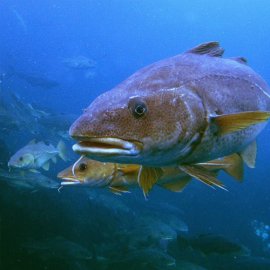Healing Wounds with Fish
-
English
-
ListenPause
[intro music] Welcome to World Ocean Radio… I’m Peter Neill, Director of the World Ocean Observatory. Time and again in history we hear of natural treatments for breaks, wounds, and diseases. Our ancestors brewed herbal teas, treated wounds with moss and leaves, and otherwise practiced a healing system derived from natural materials. The tradition continues in the practice of homeopathic medicine in various forms in both East and West and the global industry in organic supplements that offers an alternative practice to the synthetic, and expensive methodology that characterizes the health care system in the United States and elsewhere. As medicine has become standardized and mechanized and arbitrated by the insurance, pharmaceutical, and efficiency-driven practices of our time, we have lost some of that historical wisdom and its healing effect. We speak often in these editions of World Ocean Radio of the innovative and effective inventions and organizations in Iceland, a small country with a big heart, big ideas, and a powerful natural environment that provides not only its energy and food requirements, but also a basis for adaptation and invention of natural products and processes to drive its 21st century economy and culture. As Iceland relies heavily on fishing in its mix of finance and labor applications, it must stay competitive against larger, industrialized fishing nations by maximizing the value of its fish products, using 100% of the fish. This seems obvious, but in the US for example, our industry wastes more than half by discarding by-catch, harvesting only specialized high-cost species, and failing to capture the added economic opportunity of such limited application and interest. In a June article in Bloomberg BusinessWeek, Lois Parshley reports on development of a fish skin based, FDA approved treatment for chronic wounds and inflammation – 100% of the fish indeed. The only hint of its origin is a scale-like grid that also provides a matrix for binding around which new, healthy skin can grow. I had seen this product in Reykjavik, but if was not yet approved by the US Food and Drug Administration until late last year. Called Omega 3 Wound, the product is produced by Kerecis Limited, a small company located in Isafjordur, a town of 3,000 inhabitants with a limited economy based of fishing and small scale tourism that now has a new employer at work. According to Fertram Sigurjonsson, CEO of Kerecis, the product has taken nine years to develop and test successfully, using the skin of cod fish caught locally, cleaned, dried, sterilized, and packaged for treatment of chronic wounds, burns, oral cancer, internal, cosmetic and reconstructive surgeries, and other applications for the reduction of inflammation and pain. The market implication is large. According to Parshley’s article, “Some six and a half million Americans suffer from chronic wounds, whether related to vascular disease, diabetes, or complications from normal procedures. The five-year survival rate is 54%,…and treatments cost more than $25 billion a year.” Parshley continues, “The US Department of Defense is on the look-out for better burn treatments because of the increase in service wounds from improvised explosive devices. In a study [conducted by the US Army Institute of Surgical Research] , the fish skin bested the healing rates of cadaver skin, a common military treatment for burns. The Army has also funded several further studies, showing that unlike rival products, fish skin can ward off bacteria and reduce bleeding.” So what we have here is a turning of the circle of knowledge, the re-discovery and re-application of the healing property of fish oil , harvested as a value added from a traditional food product, enabling new employment for fishing communities and innovative, more powerful treatment for the injuries of modern war and of many other conditions that can be better and faster healed by a natural process derived from the ocean. That is the true message here – that the ocean has such an enormous, known and unknown, implication for human health. When we fail to use it well, or worse, when we despoil or exhaust it, we are depriving ourselves and our children from its healing properties – in a simple bandage, a new medicine, or the purity of the food we eat, the water we drink, and the air we breathe. The sea connects all things. We will discuss these issues, and more, in future editions of World Ocean Radio. This summer we are revisiting some of our favorite episodes that highlight optimism in ocean news, science and advocacy. World Ocean Radio is distributed by the Public Radio Exchange and the Pacifica Network for use by college and community radio stations worldwide. Find us wherever you listen to podcasts, and at world ocean observatory dot org. [outro music]
This summer we are revisiting some of our favorite World Ocean Radio episodes that highlight optimism for the ocean. This week we are discussing an innovative company in Iceland that has developed a product from fatty acid-rich fish skin to treat chronic wounds so that new skin can grow. Called Omega 3 Wound and developed by Kerecis Limited, this FDA-approved skin is grafted onto damaged human tissue such as a burn or a diabetic wound, and is ultimately converted into living tissue. This product illustrates the capacity to use 100% of the fish, thereby maximizing the value of the catch and accelerating economic opportunity around the globe.
About World Ocean Radio
5-minute weekly insights dive into ocean science, advocacy and education hosted by Peter Neill, lifelong ocean advocate and maritime expert. Episodes offer perspectives on global ocean issues and viable solutions, and celebrate exemplary projects. Available for syndicated use at no cost by college and community radio stations worldwide.
Image
NTNU, Faculty of Natural Sciences, CC BY 2.0
Creative Commons licenses 2.0 via Wikimedia Commons
commons.wikimedia.org/wiki/File:Torsk._Cod.jpg
Episode Resources
< Kerecis.com | Fish Skin Technology to Heal Human Wounds
- Login to post comments



